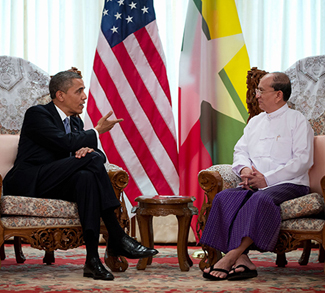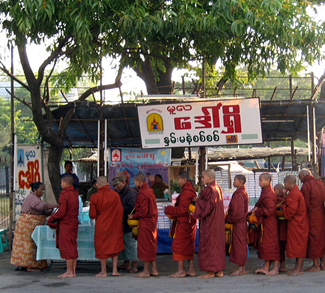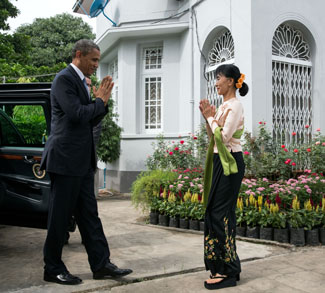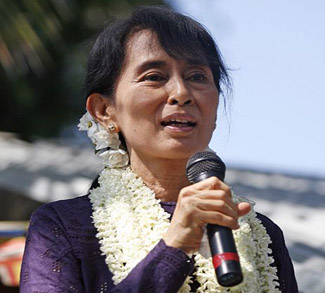During the period of strict economic sanctions and export bans that Western countries levied against Myanmar through the 1990s and 2000s, the military government had little choice but to turn to China. China, with its deep pockets and a strategic focus on the periphery, was more than happy to invest in the isolated state, increasing Myanmar’s dependence and furthering Beijing’s own military and economic interests by tapping into the poorer state’s promising energy reserves and vying for coastal access to the Indian Ocean.
In 2010, Myanmar’s longstanding ruling junta decided to step down and make way for an elected government. Though the military remains the most powerful force in Burmese politics, democratic policies have steadily moved forward. These liberal reforms have effectively warmed relations with new potential partners, most notably the United States and India.
Myanmar’s partnership with India is not a new. Despite being one of the largest and most powerful democratic states in the region, India never produced the kind of ideological opposition to Burmese authoritarianism that was common of the United States and Europe. New Delhi’s lukewarm and half-hearted censures reflected its desire to compete with Chinese influence in the region, both geopolitically and in terms of access to resources, and consequently India often flirted with the idea of offering assistance and development packages to Myanmar.
However, these efforts were stymied time and time again. The Indian government, awkwardly positioned as a democracy courting a junta, was never able to decide on a long term strategy. Though it made some large-scale investments in Burmese infrastructure, New Delhi lacked a consistent focus to guide its foreign policy over the years, flip-flopping between democracy-promotion, capacity-building and development assistance projects. Most Indian private enterprises were frightened off by the instability and frequent anti-foreigner business crackdowns of the Burmese government, leaving the majority of investment activity in the hands of a largely corrupt and sluggish Indian government. As a result, cooperation between India and Myanmar never reached the levels it could have.
India’s loss was China’s gain, and Beijing emerged as Myanmar’s primary partner during its isolation from the international community. Rich in capital and labor, and guided by its own vested interests, China’s investments and joint ventures in Myanmar dwarfed those of any other country.
Yet this was a relationship forged from necessity, not amity. Complaints abound in Myanmar that Chinese officials and workers demonstrated a marked disregard for Burmese culture and customs. Moreover, the growing dependence on Chinese business did not go unnoticed by the government of Myanmar, which has no desire to lose control over its abundant energy resources or unique strategic potential.
A desire to decrease reliance on China is frequently cited as a partial explanation for the democratic reforms that were launched in 2010. Since then, power has been handed to a civilian government, elections have been held, political prisoners have been released, and Aung San Suu Kyi, the beloved pro-democracy politician who has spent over a decade under house arrest, has been recognized as a legitimate leader and permitted to take her seat in Burmese parliament.
The United States, a country that took the lead on the international isolation of Myanmar, has seemingly accepted these indications of democratization. President Obama and former Secretary of State Hillary Clinton have both visited Myanmar as a show of support. Recently, Myanmar’s civilian president, Thein Sein was welcomed to the White House – the first Burmese leader to visit in a generation. Though some restrictions on doing business with Myanmar remain, the US has clearly warmed in its stance, suggesting that there may be promising opportunities for political and economic partnership in the future.
For Myanmar, this warming represents an opportunity to break free from excess Chinese influence and diversify its economic and development portfolios. American presence would also be particularly welcome in certain regions where cultural tensions with China run thick. The China-Myanmar border is a notoriously fragmented region with a myriad of ethnic fault lines, so a wider range of prospective partners might help the government avoid inflaming ethnic animosities.
For the Americans, Myanmar represents a potential political victory, provided the effectiveness of soft power in promoting a nascent democracy can continue to be demonstrated. Myanmar has also been the sticking point blocking American access to the Association of Southeast Asian Nations, the regional bloc with which Washington hopes to cooperate in order to strengthen new markets and check China’s dominance in the region.
With the United States setting the example of how to engage with Myanmar, it may be that the Indian government follows their lead. Reconciliation between Thein Sein’s government and Western democracies seems to be helping to focus New Delhi’s foreign policy towards Myanmar, which is now producing some tangible efforts to invest in Burmese infrastructure. A functioning and reliable relationship with India would allow Myanmar to further break free of Chinese dependence, and mitigate the risk of Myanmar nurturing a similar dependence on the Americans.
Aside from the benefits of a diverse and independent foreign policy, having three strong possibilities for international partnership rather than just an eager China and a timid India presents an opportunity for Myanmar to leverage offers. It can now adopt a more competitive foreign policy, similar to how third-world governments would play superpowers off against each other during the Cold War in order to meet domestic needs and secure favourable bids from wealthier governments.
For the time being, China continues to fill Myanmar’s field of vision, but with American relations becoming more prominent in the periphery, and India preparing to redouble its efforts, Burmese foreign policymakers foresee a triangular relationship developing in the future, one in which each pole can offer unique opportunities for growth and development.




